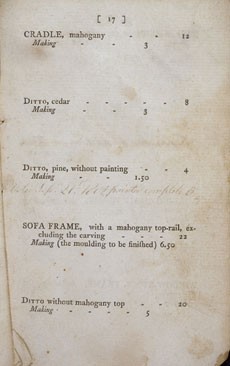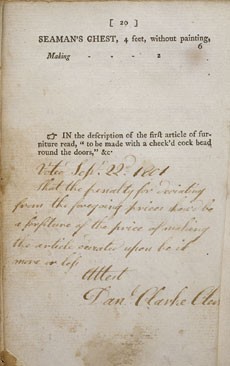
George Washington Felt, View of Court House Square, Salem, Massachusetts, 1810–1820. Oil on wood panel. 35" x 52". (Courtesy, Peabody Essex Museum; gift of B. F. Brown.)

John Christian Rauschner, William Hook, ca. 1809. Colored wax. H. (frame) 6 1/2". (Courtesy, Peabody Essex Museum; photo, Mark Sexton.)

Gentleman’s secretary, Salem, Massachusetts, 1795–1805. Mahogany with pine. H. 96 3/8", W. 72 1/8", D. 20 1/4". (Courtesy, Museum of Fine Arts, Houston; gift of Miss Ima Hogg.)

Design for a “Gentleman’s Secretary” illustrated on plate 52 of Thomas Sheraton’s The Cabinet-Maker and Upholsterer’s Drawing Book (1793). (Courtesy, Winterthur Museum Library: Printed Books and Periodical Collection.)

Thomas Shearer, design for a “Wing Clothes Press,” illustrated on plate 3 of the Society of Upholsterers, Cabinet-Makers’ London Book of Prices (1788). (Courtesy, Winterthur Museum Library: Printed Books and Periodical Collection.)

Gentleman’s secretary attributed to Edmund Johnson, Salem, Massachusetts, 1795–1812. Mahogany and satinwood with pine. H. 88", W. 67 1/2", D. unrecorded. (Courtesy, Sotheby’s.)

Secretary-and-bookcase, Salem, Massachusetts, 1795–1800. Mahogany with pine. H. 91 1/2", W. 45", D. 23". (Courtesy, Peabody Essex Museum, bequest of Mrs. Arthur West; photo, Mark Sexton.)

Secretary-and-bookcase with the label
of William Appleton, Salem, Massachusetts, 1795–1804. Mahogany and pine. H. 99 1/2", W. 42", D. 24 1/2". (Courtesy, Winterthur Museum.) An inlaid scroll volute similar to those on this example is illustrated in a design for a bookcase on plate 1 of the Society of Upholsterer’s Cabinet-Makers’ London Book of Prices.

Design for a “Side Board” illustrated on plate 29 of the second edition of George Hepplewhite’s Cabinet-Maker and Upholsterer’s Guide (London, 1789). (Courtesy, Winterthur Museum Library: Printed Books and Periodical Collection.)
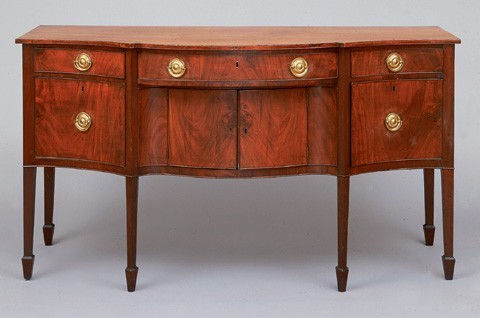
Sideboard made by Daniel Clarke, Salem, Massachusetts, 1797. Mahogany with pine. H. 37 3/4", W. 68 1/2", D. 28". (Courtesy, Peabody Essex Museum, gift of Eliza and Mary Ropes; photo, Mark Sexton.) This sideboard differs from the design illustrated in fig. 9 in having a cabinet with two doors beneath the center drawer.

Sideboard bearing the label of Edmund Johnson, Salem, Massachusetts, 1800–1810. Mahogany with pine. H. 39 1/2", W. 63 1/2", D. 26 1/4". (Private collection; photo, Decorative Arts Photographic Collection, Winterthur Museum.)

Sideboard attributed to Nathaniel Safford, Salem, Massachusetts, 1805. Mahogany with pine. H. 42", W. 69", D. 26". (Private collection; photo, Mark Sexton.)

Desk attributed to Elijah Sanderson, Salem, Massachusetts, 1780–1800. Mahogany and pine. H. 43 3/8", W. 45", D. 23". (Courtesy, New England Historic Genealogical Society.)

Desk by Edmund Johnson, Salem, Massachusetts, ca. 1800. Cherry with pine. H. 45", W. 21", D. 42 1/4". (Courtesy, Peabody Essex Museum; gift of F. J. Bradlee.)

Dwarf clock with movement by Samuel Mulliken II, Salem, Massachusetts, 1790–1796. Mahogany with pine; brass. H. 36 3/8", W. 11 3/4", D. 7". (Courtesy, Peabody Essex Museum; photo, Mark Sexton.)

Design for a “Commode” illustrated on plate 78 of the third edition of George Hepplewhite’s Cabinet-Maker and Upholsterer’s Guide (1794). (Courtesy, Winterthur Museum Library: Printed Books and Periodical Collection.)
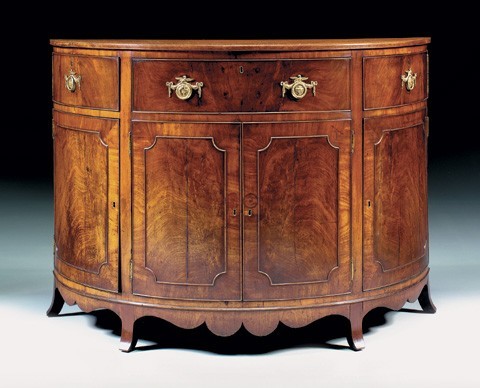
Commode, Salem, Massachusetts, 1800–1810. Mahogany with pine. H. 40", W. 55", D. 32". (Courtesy, Christie’s.)

Commode with carving attributed to Samuel McIntire, Salem, Massachusetts, 1800–1805. Mahogany with pine. H. 43 1/4", W. 65 3/4", D. 28 1/4". (Courtesy, Decorative Arts Photographic Collection, Winterthur Museum.)

Lady’s secretary, Salem, Massachusetts, 1800–1810. Mahogany with pine. H. 61 1/4", W. 38", D. 29 1/4". (Courtesy, Peabody Essex Museum; bequest of Mrs. Arthur West.)

Design for a “Secretary and Bookcase” illustrated on plate 44 of the third edition of George Hepplewhite’s Cabinet-Maker and Upholsterer’s Guide (1794). (Courtesy, Winterthur Museum Library: Printed Books and Periodical Collection.)

Lady’s tambour writing table by Elijah Sanderson, Salem, Massachusetts, 1800–1810. Mahogany with pine. Dimensions not recorded. (Courtesy, Decorative Arts Photographic Collection, Winterthur Museum.)

Circular front bureau, Salem, Massachusetts, 1795–1813. Mahogany and birch with pine. H. 37 1/2", W. 41", D. 21 1/2". (Courtesy, Peabody Essex Museum; gift of Francis and Miriam Shaw.) The chest descended in the family of Salem merchant Aaron Waite.

Dining table, eastern Massachusetts, 1795–1815. Birch. H. 28", W. 47 1/2", D. 46". (Courtesy, Peabody Essex Museum; gift of Charles Cotting, Jr.)

Card table attributed to William and Samuel Fiske, Salem, Massachusetts, 1795–1800. Mahogany with pine. H. 28 1/2", W. 35 3/4", D. 19 1/2". (Courtesy, Peabody Essex Museum; bequest of Mrs. Isabel Newcomb.)

Night table made by Elijah Sanderson, Salem, Massachusetts, ca. 1800. Mahogany with pine. H. 29 1/2", W. 25 3/4", D. 19". (Private collection; photo, Peabody Essex Museum.)

Designs for “Night Tables” illustrated on plate 82 of the third edition of George Hepplewhite’s Cabinet-Maker and Upholsterer’s Guide (1794). (Courtesy, Winterthur Museum Library: Printed Books and Periodical Collection.)

Pembroke table, possibly Salem, Massachusetts, 1795–1810. Mahogany with pine. H. 28", W. 33 1/2", D. 33 1/2". (Courtesy, Peabody Essex Museum.)

Quarter table, probably Maryland, 1795–1810. Mahogany with pine and tulip poplar. H. 32 3/4", W. 32 3/4", D. 22 7/8". (Courtesy, Winterthur Museum.)

Table, Salem, Massachusetts, ca. 1789. Pine; black, brown, white, and ochre paint. H. 30 1/4", W. 42", D. 22 1/4". (Courtesy, Peabody Essex Museum; gift of Ellen Chever.)

Stand, Salem, Massachusetts, 1795– 1805. Mahogany. H. 30 1/2", W. 24", D. 15 1/2". (Courtesy, Peabody Essex Museum; gift of Mrs. George Nichols.)

Firescreen, Salem, Massachusetts, 1795–1805. Mahogany. H. 59 3/4", W. 17 1/2", D. 17 1/2". (Courtesy, Peabody Essex Museum; bequest of George Rea Curwen.)

Design for a “Corner Basin Stand” illustrated on plate 42 of Thomas Sheraton’s Cabinet-Maker and Upholsterer’s Drawing Book (1793). (Courtesy, Winterthur Museum Library: Printed Books and Periodical Collection.)

Corner washstand, Salem, Massachusetts, 1800–1815. Mahogany with pine. H. 41", W. 14 1/2", D. 14 1/2". (Courtesy, Peabody Essex Museum; photo, Mark Sexton.)

Cradles, Salem, Massachusetts, 1790–1810. (left) Mahogany with pine. H. 29", L. 40", W. 21 1/2". (right) Pine; blue-green paint. H. 31", L. 40", W. 20". (Courtesy, Peabody Essex Museum; [left] gift of Mr. and Mrs. Joseph K. Elliot.)

Sofa, possibly by Nathaniel Safford, with carving attributed to Samuel McIntire, Salem, Massachusetts, ca. 1805. Mahogany with unidentified secondary woods. H. 38 1/2", L. 83", D. 33". (Private collection; photo, Mark Sexton.)

Easy chair, Salem, Massachusetts, ca. 1800. Mahogany. H. 48", W. 27 1/2", D. 21". (Courtesy, Peabody Essex Museum, bequest of George Rea Curwen; photo, Mark Sexton.)

Design for an “Easy Chair” illustrated on plate 15 of the second edition of George Hepplewhite’s Cabinet-Maker and Upholsterer’s Guide (1789). (Courtesy, Winterthur Museum Library: Printed Books and Periodical Collection.)

Armchair, Salem, Massachusetts, 1795–1805. Mahogany with unidentified secondary woods. H. 43 1/2", W. 23", D. 19 1/2". (Courtesy, Peabody Essex Museum; gift of George Rea Curwen.)
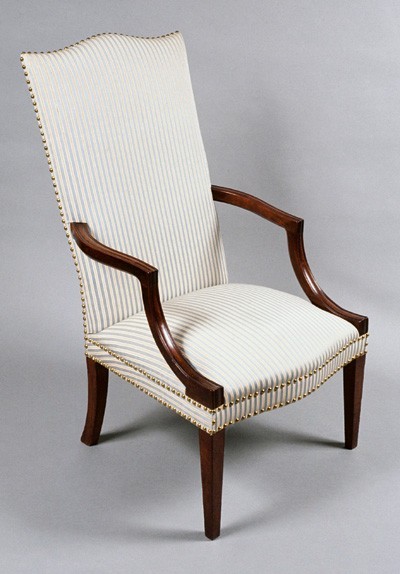
Lolling chair, Salem, Massachusetts, ca. 1805. Mahogany with unidentified secondary woods. H. 42", W. 24", D. 21". (Private collection; photo, Peabody Essex Museum.)

Window stool with carving attributed to Samuel McIntire, Salem, Massachusetts, 1801. Mahogany with unidentified secondary woods. H. 26", W. 44 1/2", D. 14 3/4". (Courtesy, Peabody Essex Museum, gift of the estate of Charlotte Nichols; photo, Mark Sexton.)

Designs for “Window Stools” illustrated on plate 19 of the third edition of George Hepplewhite’s Cabinet-Maker and Upholsterer’s Guide (1794). (Courtesy, Winterthur Museum Library: Printed Books and Periodical Collection.)

Detail of a bed post with carving attributed to Samuel McIntire, 1801–1811. Mahogany. H. 76", W. 4", D. 4". (Courtesy, Peabody Essex Museum, gift of the estate of Charlotte Nichols; photo, Mark Sexton.)

Bedstead, Salem, 1795–1801. Mahogany and maple with pine. H. 87", W. 57", D. 79". (Courtesy, Peabody Essex Museum, gift of Deborah J. Elliot: photo, Mark Sexton.)

Folding cot, probably Salem, Massachusetts, nineteenth century. Maple, pine, iron, and canvas. H. 25", W. 79", D. 55". (Courtesy, Peabody Essex Museum; photo, Mark Sexton.)

Luxe et Indigence, France, ca. 1818. Engraving. Dimensions not recorded.

Sea chest, probably Salem, Massachusetts, 1811–1830. Pine; gray paint. H. 18 3/4", W. 49 1/2", D. 18". (Courtesy, Peabody Essex Museum, gift of the Reverend George D. Latimer; photo, Mark Sexton.) This chest belonged to Capt. Charles Hoffman of Salem.

Michele Felice Cornè, The Death of William, Salem Massachusetts, ca. 1807. Watercolor on paper. 19 1/2" x 15". (Courtesy, Peabody Essex Museum; deposit of Mrs. Nathaniel S. Sanders.) The decceased was a mamber of the Webb or Luscomb family of Salem.
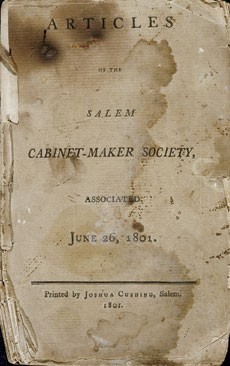
Articles of the Salem Cabinet-Maker Society, Associated. June 26 1801. Printed by Joshua Cushing, Salem 1801. (To scroll through all the pages click on the image.)














